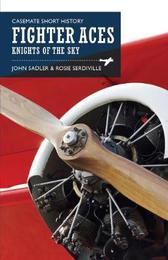
|
Fighter Aces: Masters of the Skies
Paperback
Main Details
| Title |
Fighter Aces: Masters of the Skies
|
| Authors and Contributors |
By (author) John Sadler
|
|
By (author) Rosie Serdiville
|
| Series | Casemate Short History |
|---|
| Physical Properties |
| Format:Paperback | | Pages:160 | | Dimensions(mm): Height 198,Width 125 |
|
| ISBN/Barcode |
9781612004822
|
| Classifications | Dewey:358.4383 |
|---|
| Audience | |
|---|
|
Publishing Details |
| Publisher |
Casemate Publishers
|
| Imprint |
Casemate Publishers
|
| Publication Date |
14 June 2017 |
| Publication Country |
United States
|
Description
Just over a decade after the first successful powered flight, fearless pioneers were flying over the battlefields of France in flimsy biplanes. As more aircraft took to the skies, their pilots began to develop tactics to take down enemy aviators. Though the infantry in their muddy trenches might see aerial combat as glorious and chivalric, the reality for these `Knights of the Sky' was very different and undeniably deadly: new Royal Flying Corps subalterns in 1917 had a life expectancy of 11 days. In 1915 the term `ace' was coined to denote a pilot adept at downing enemy aircraft, and top aces like the Red Baron, Rene Fonck and Billy Bishop became household names. The idea of the ace continued after the 1918 Armistice, but as the size of air forces increased, the prominence of the ace diminished. But still, the pilots who swirled and danced in Hurricanes and Spitfires over southern England in 1940 were, and remain, feted as `the Few' who stood between Britain and invasion. Flying aircraft advanced beyond the wildest dreams of Great War pilots, the `top' fighter aces of World War II would accrue hundreds of kills, though their life expectancy was still measured in weeks, not years. World War II cemented the vital role of air power, and post-war innovation gave fighter pilots jet-powered fighters, enabling them to pursue duels over huge areas above modern battlefields. This entertaining introduction explores the history and cult of the fighter ace from the first pilots through late 20th century conflicts, which leads to discussion of whether the era of the fighter ace is at an end.
Author Biography
John Sadler BA (Hons) M.Phil, FRHistS, FSA (Scotl.) is an author, lecturer, battlefield tour guide and historical interpreter. He has been a visiting lecturer at the North East Centre for Lifelong Learning teaching war studies for fifteen years and has some thirty published titles in print or preparation. He is an experienced battlefield tour guide for both world wars in Europe and for a range of earlier conflicts. As a historical interpreter and partner in Time Bandits, he has appeared in a wide variety of guises in museums, galleries, schools, the community and heritage sites from Ramses II of Egypt to WWII Home Guard and Auxiliaries. He is married with two daughters and lives in mid-Northumberland. Rosie Serdiville is a writer and educator with a particular interest in radical history. She works together with John Sadler in schools and for heritage sites, often using our very different viewpoints to provide an alternative commentary on historical events. She is Vice President of the Society of Antiquaries of Newcastle upon Tyne, and co-author with John Sadler of 7 military history titles.
ReviewsThese books would be excellent for someone with an early interest in military history or for someone talking history at school. Very readable and easy to understand with some good illustrations. * Army Rumour Service * Fighter Aces is part of Casemate's brilliant new series: Short Histories. * Books Monthly *
|